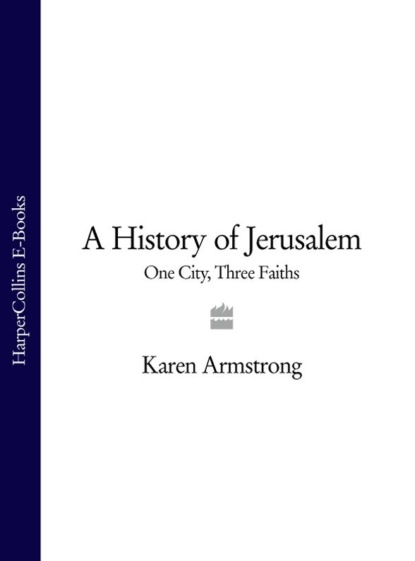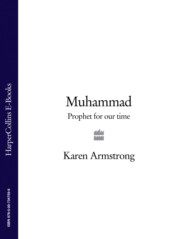По всем вопросам обращайтесь на: info@litportal.ru
(©) 2003-2024.
✖
A History of Jerusalem: One City, Three Faiths
Настройки чтения
Размер шрифта
Высота строк
Поля
Abdi-Hepa almost certainly never received his troops: indeed, at this time the hill country was fast becoming a demilitarized zone.
(#litres_trial_promo) The fortified town of Shiloh, for example, was abandoned and 80 percent of the smaller highland settlements had disappeared by the early thirteenth century. Some scholars believe that it was during this period of unrest that the people whom the Bible calls the Jebusites established themselves in Jerusalem. Others claim, on the basis of the literary evidence, that the Jebusites, who were closely related to the Hittites, did not arrive in the country until after the fall of the Hittite empire, which was situated in what is now northern Turkey, in about 1200 BCE.
(#litres_trial_promo) It is impossible to be certain about this one way or the other. Certainly, the archaeological investigations do not, as yet, indicate a change in the population of Jerusalem at the end of the Late Bronze Age (1550–1200 BCE). It has also been suggested that the Jebusites were simply an aristocratic family who lived in the citadel, separately from the people in the town itself.
(#litres_trial_promo) It could, therefore, have been the Jebusites who repaired the old fortifications on the Ophel and built a new district on the eastern slope between the wall and the summit of the hill. Kathleen Kenyon unearthed a series of stone-filled terraces which, she believed, made this steep terrain habitable and replaced the old straggling houses and plunging streets. The work took a long time; Kenyon claimed that the project was begun in the mid-fourteenth century but was not completed until the early thirteenth century. Some of the walls were thirty-three feet high, and construction was often interrupted by such natural disasters as earthquakes and soil erosion.
(#litres_trial_promo) As well as providing accommodation, this new structure was probably also part of the city’s defenses. Kenyon thought that it could have been the “Millo” mentioned by the biblical writers:
(#litres_trial_promo) since some of the later kings of Judah made a point of repairing the Millo, it probably had a military function. It may well have been part of the city’s fortress on the crest of the Ophel. It has been suggested that the name “Zion” did not refer to the whole city of Jerusalem but originally denoted the fortress which protected the town on its northern and more vulnerable side.
During the Amarna period, Jerusalem seems to have remained loyal to Shalem, its founder-god. Abdi-Hepa speaks in his letters to the pharaoh of “the capital of the land of Jerusalem, of which the name is Beit-Shulmani [House of Shalem].”
(#litres_trial_promo) But scholars believe that the Hurrians brought a new god to the city: the storm god Baal, who was worshipped by the people of Ugarit on the Syrian coast.
(#litres_trial_promo) We know about Baal’s cult there from the cuneiform tablets which were discovered at Ras Shamra (the modern city on the site of ancient Ugarit) in 1928. We should pause briefly to consider it, because it would have a great impact on the spirituality of Jerusalem.
Baal was not the chief god of the Syrian pantheon. His father was El, who would also make an appearance in the Hebrew Bible. El lived in a tent-shrine on a mountain, near the confluence of two great rivers which were the source of the world’s fertility. Each year the gods used to assemble there to take part in the Divine Council to establish the laws of the universe. El, therefore, was the fount of law, order, and fecundity, without which no human civilization could survive. But over the years, like other high gods, El became a rather remote figure, and many people were attracted by his more dynamic son Baal, who rode upon the clouds of heaven and hurled lightning from the skies to bring the life-giving rain to the parched earth.
But Baal had to fight to the death to secure the earth’s fruitfulness. In the Near East, life was often experienced as a desperate struggle against the forces of chaos, darkness, and mortality. Civilization, order, and creativity could be achieved only against great odds. People told stories about the mighty battles fought by the gods at the dawn of time which brought light out of darkness and order out of chaos and kept the lawless elements of the cosmos within due and manageable bounds. Thus in Babylon, the liturgy commemorated the battle of the young warrior god Marduk, who slew the sea-monster Tiamat, split her carcass in two, and created the world. There were similar stories about Baal. In one myth, he fought the seven-headed sea-monster Lotan, who is called “Leviathan” in the Hebrew Bible. In almost all cultures, the dragon or the monster has symbolized the unformed and the undifferentiated. By slaying Lotan, Baal had halted the slide back to the formless waste of chaos from which all life—human and divine—had sprung. The myth depicts a fear of extinction and annihilation that, especially in these early days of civilization, was a perpetual possibility.
The same terror can be felt in the stories of Baal’s other battles, against the sea and the desert—two natural forces that threatened these early cities of the Near East. The sea represented everything that the civilized world was not and everything it feared. It had no boundaries, no shape. It was vast, open, and unformed. At the same time, the barren steppes constantly threatened to encroach on the fertile land, which alone was suitable for human habitation. The myths of Ugarit told the story of Baal’s desperate fight with Yam-Nahar, the god of the seas and rivers, and Mot, the god of death, sterility, and drought. Mot in particular was death imagined as a voracious force, insatiably craving human flesh and blood. Baal overcame both these foes only with great difficulty: the battle with Mot was especially frightening, since, it seems, Baal was taken prisoner in the underworld—Mot’s domain—the “abyss” of fearful nothingness. During Baal’s imprisonment the earth was scorched by drought and reduced to desert. Finally Baal prevailed. Yet his victory was never complete. Yam and Mot both survived: the frightening power of Chaos was a perennial possibility and Death the most ineluctable of certainties. Gods and men had to join forces and fight an endless battle against them.
To celebrate his victory, Baal asked El’s permission to build a palace for himself. This was quite common in ancient myth. After Marduk had created the world, gods and humans worked together to build the city of Babylon at the center of the earth. At Bab-ilani (“The Gate of the Gods”) the deities could assemble each year to take part in the Divine Council: it was their home in the mundane world of men and women, who knew that they could gain access to them there. At the center of the city, they also built Marduk’s great temple of Esagila, his palace in the city. There he lived and imposed the divine order, through his vicegerent the king. Architecture was thus seen as a divinely inspired exercise. The great stone cities, temples, and ziggurats seemed such colossal achievements that the human beings who had created them appeared to have transcended themselves. They were a permanent reminder of the human-divine victory against formlessness and disorder.
Similarly, Baal could not rule over the gods without a palace. Once he was properly housed in his celestial mansion of gold and lapis lazuli above Mount Zaphon, Baal had truly become “Lord,” as his name suggests. Henceforth, Baal alone would rule gods and men alike. As he proclaimed:
[For] I alone am he that shall be king over the gods,
[that] indeed fattens gods and men,
that satisfies the multitudes of the earth.
(#litres_trial_promo)
In his temple, Baal and his consort, Anat, celebrated their great victories which had restored order to the world:
Did I not destroy Yam the darling of El …
Was not the dragon captured and vanquished?
I did destroy the wiggling serpent,
the tyrant with seven heads.
(#litres_trial_promo)
The people of Ugarit, who lived just twenty miles from Baal’s dwelling on Zaphon, felt that because they lived in Baal’s territory they shared in his victory. In the hymns of Ugarit, Baal calls Zaphon “the holy place, the mountain of my heritage … the chosen spot … the hill of victory.” Zaphon was the center of their world. It was a “holy mountain,” a “beautiful height,” and the “joy of the whole earth.”
(#litres_trial_promo) Because Baal lived there, he had made Zaphon an earthly paradise of peace, fertility, and harmony. There he would “remove war from the earth. Pour out peace in the depths of the earth.” “Love would increase in the depths of the fields.”
(#litres_trial_promo) To make sure that they would also enjoy this divine fertility and peace, the people of Ugarit built a temple which was a replica of Baal’s palace on Mount Zaphon. They copied it down to the last detail that had been revealed to them, so that, according to the principle of imitatio dei, Baal would dwell with them too. Thus heaven would come to earth in their city and they would create an enclave of life as it was meant to be in the midst of a dangerous world.
Baal’s presence among them in his temple made human life possible in Ugarit. When the people entered the temple, they felt that they had entered another dimension of existence and were once again in communion with the natural and divine rhythms of life that were normally hidden from them. They could hear
The speech of wood and the whisper of stones,
the converse of heaven with the earth
Of the deeps with the stars.
… lightning which the heavens do not know,
Speech which men do not know
And the multitude of the earth do not understand.
(#litres_trial_promo)
In the ancient world, the temple was often experienced as a place of vision, where people learned to see further and in a different way. They were stretching themselves imaginatively to see into the life of things. The liturgy and the architecture of the temple were part of that creative effort to imagine a fuller and more intense mode of existence. But it was also a program for action. In their ritual, the people of Ugarit reenacted the battles of Baal and his enthronement on Mount Zaphon in a sacred drama. This autumnal festival marked the start of the New Year: Baal’s victories were repeated and imitated so that the lifegiving rain would fall once again and the city be preserved in safety against the lawless forces of destruction. This enthronement ceremony also made Ugarit part of Baal’s “eternal heritage,”
(#litres_trial_promo) a haven—or so they hoped—of peace and plenty.
A central figure in the liturgy was the person of the king, who sat enthroned, his head glistening with the oil of victory as Baal’s representative. Like other kings in the Near East, he was regarded as the viceroy of the god and had clearly defined duties. At this point, the people of the Near East did not have extravagant hopes of religion. “Salvation” for them did not mean immortality: that was a prerogative of the gods alone. Their aim was more modest: to help the gods to sustain a decent, ordered life on earth, holding hostile forces at bay. War was an essential part of the king’s duties: the enemies of a city were often identified with the forces of chaos, because they could be just as destructive. Yet war was waged for the sake of peace. At his coronation, a Near Eastern king would often swear to build temples for the gods of his city and keep them in good repair. Thus the city’s lifeline to the divine world would be preserved intact. But he also had a duty to build canals for the city and to ensure that it was properly fortified at all times. No city was worthy of the name if it could not provide its citizens with security from their enemies. At the beginning and end of the Babylonian Epic of Gilgamesh, the people of Uruk were exhorted to admire the strength and craftsmanship of the city walls:
Inspect the foundation terrace and examine the brickwork
If its brickwork be not of burnt bricks
and if the seven [wise men] did not lay its foundations.
(#litres_trial_promo)
King Gilgamesh had tried to transcend the human condition; he had left his city and gone to seek eternal life. His quest failed, but, the poet tells us, at least he had been able to ensure that his city was safe from attack, and had anchored himself in Uruk, the one place on earth that he was meant to be.
But a Near Eastern king also had another task. He had to impose the law, which was widely regarded as a divine creation which had been revealed to the king by the gods. In a famous stele, the great eighteenth-century Babylonian king Hammurabi is shown standing in front of the enthroned god Shemesh and receiving the laws from him. In his law code, he asserts that he was appointed by the gods
to cause justice to prevail in the land,
to destroy the wicked and the evil,
that the strong might not oppress the weak.
(#litres_trial_promo)
Besides maintaining the physical fabric of the city, the king was bound to preserve its social order. It was no good building fortifications against external foes if exploitation, poverty, and discontent were likely to cause instability within the city. The king therefore presented himself as the shepherd of his people, as Hammurabi explained in the epilogue of his code:
I made the people rest in friendly habitations;









